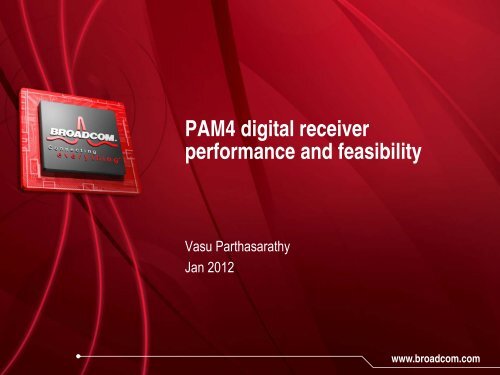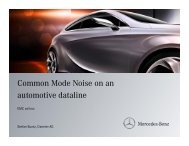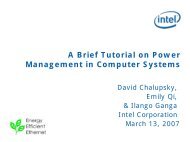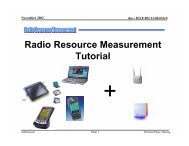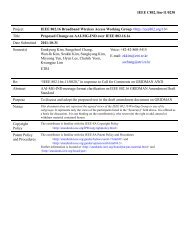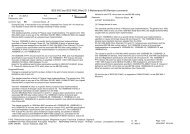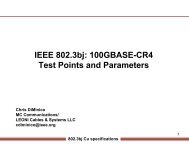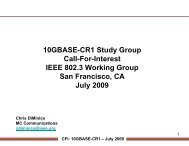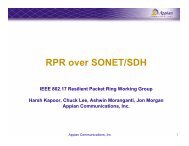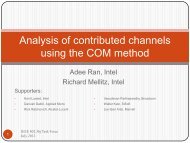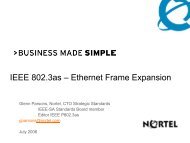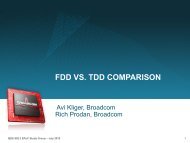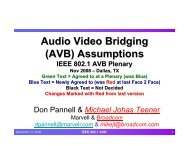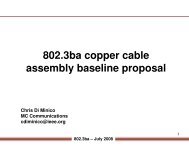PAM4 digital receiver performance and feasibility
PAM4 digital receiver performance and feasibility
PAM4 digital receiver performance and feasibility
Create successful ePaper yourself
Turn your PDF publications into a flip-book with our unique Google optimized e-Paper software.
<strong>PAM4</strong> <strong>digital</strong> <strong>receiver</strong><br />
<strong>performance</strong> p <strong>and</strong> <strong>feasibility</strong>y<br />
Vasu Parthasarathy<br />
Jan 2012<br />
www.broadcom.com
Supporters <strong>and</strong> Contributors<br />
• Howard Frazier, Broadcom<br />
• Will Bliss, Broadcom<br />
• Kent Lusted, Intel<br />
• Rich Mellitz Mellitz, Intel<br />
• Sanjay Kasturia, Inphi<br />
• Hamid Rategh, Inphi<br />
• Adee Ran, Intel<br />
• Matt Brown, Applied Micro
Objectives<br />
• Explore <strong>PAM4</strong> <strong>performance</strong> on channels submitted to .ap as well as<br />
recent submissions<br />
• These channels have generally been accepted as difficult for most line<br />
codes<br />
• Evaluate tradeoffs between complexity <strong>and</strong> <strong>performance</strong> with a <strong>digital</strong><br />
ADC based <strong>receiver</strong> architecture<br />
ADC based <strong>receiver</strong> architecture<br />
• Demonstrate technical <strong>feasibility</strong> of the architecture for supporting 100<br />
Gbps operation
100GBASE-KR4 Digital Transceiver Block Diagram<br />
FEC<br />
encoder d<br />
PMA<br />
fframer<br />
Tx<br />
Pre-coder<br />
with ith block bl k<br />
termination<br />
TIMING<br />
RECOVERY<br />
Tx<br />
de de-emph emph<br />
VGA CTF ADC FFE SLICER<br />
e<br />
e<br />
+<br />
e<br />
e<br />
-<br />
DFE<br />
Driver<br />
Pre-coder<br />
ddecoder/FEC d /FEC<br />
FEC
Simulation Setup<br />
• Digital Receiver Architecture<br />
– 3 t tap FFE (1 pre,1 1 main, i 1 post), t) peaking ki filt filter ( (~8db 8db bboost t at t NNyquist), i t) ADC, ADC 32 tap t FFE, FFE 2 tap t<br />
DFE, 5 dB FEC at an increased line-rate of 27.5 Gbps (accounts for FEC overhead)<br />
• Simulation Parameters<br />
– Tx Launch = 1Vppd<br />
– Trise/fall = 20ps<br />
– Tx RJ = 0.37 ps rms<br />
– TXDJ = 00.05UI 0 UI peak-peak k k<br />
– Rx RJ = 0.37 ps rms<br />
– AWGN PSD = -154 dBm/Hz double-sided<br />
– Package g Model: s-parameters p from current 10GBASE-KR production p ppackage g ( (corresponds p to a<br />
small chip package model)<br />
– SNR Target = 24.0 dB (corresponds to BER = 10 -12 )
Channel 1: Molex 1 channel (crosstalk scaled by 8 dB)<br />
SNR margin (for 10 -12 BER ) vs ADC ENOB (<strong>receiver</strong> complexity)<br />
_____________________________________________________________<br />
1 http://www.ieee802.org/3/ap/public/channel_model/oganessyan_m1_0306.zip
Channel 2: TE Connectivity 2 channel with Nelco4000-6<br />
SNR margin (for 10 -12 BER ) vs ADC ENOB (<strong>receiver</strong> complexity)<br />
_____________________________________________________________<br />
2<br />
http://www.ieee802.org/3/100GCU/public/ChannelData/TEC_11_0428/TEC_STRADAWhisper42p8in_Nelco6_Channel_IEEE802_3_1<br />
00GbCu_04282011.zip
Channel 3: Emerson 3 channel<br />
SNR margin (for 10 -12 BER ) vs ADC ENOB (<strong>receiver</strong> complexity)<br />
_____________________________________________________________<br />
3 http://www.ieee802.org/3/100GCU/public/ChannelData/emerson_11_0928/meier_01_1011.pdf<br />
(Thru_S06-P20-10-EF_S14-P23-04-GH_NNN.s4p)
Transmitter Feasibility<br />
• Transmitters have been built with 10 taps of de-emphasis for NRZ designs at 10<br />
Gbps 4<br />
Lit t t f 5 t d h i <strong>PAM4</strong> t itt t 20 Gb 56<br />
• Literature reports of an 5 tap de-emphasis <strong>PAM4</strong> transmitter at 20 Gbps5,6 • High precision DAC’s have been fabricated around rates of 24 Gbps (12<br />
Gsamples/sec) 7<br />
• <strong>PAM4</strong> transmitter with 3 tap de de-emphasis emphasis should be feasible in current technology<br />
at a reasonable power<br />
______________________________________________________________<br />
4 D.Crivelli et. al., “Architecture <strong>and</strong> Experimental Evaluation of a 10Gb/s MLSD based Transceiver for Optical Multimode applications”,<br />
Proceedings of ICC, May 2008<br />
5 Z.Gao et. al., “A 10 Gb/s Wire-line Transceiver with Half Rate Period Calibration CDR”, Proceedings of IEEE ISCAS, May 2009<br />
6 A.Amirkhany et. al., “A 24 Gb/s Software Programmable Analog Multi-Tone Transmitter”, IEEE Journal of solid state circuits, April 2008<br />
7 Greshishchev, Y.M. et. al., “A 56GS/S 6b DAC in 65nm CMOS with 256×6b memory”, Proceedings of the IEEE ISSCC, April 2011
Existing 10.3125GS/s 6bit ADC<br />
• 10.3125GS/s ADC<br />
• 4X time ti interleaving i t l i (2 (2.5G 5G subADCs) bADC )<br />
• 6 bit ADC ENOB ≈ 5bit<br />
• 65nm CMOS process<br />
• Power = 330mW<br />
• ISSCC 2009<br />
• 28nm provides ~ 50% power saving<br />
• ENOB ENOB=6 6 requires i ~ 2 2x more power<br />
10 GS/s<br />
Data<br />
T/H<br />
TI-4<br />
TI-3<br />
TI-2<br />
TI TI-11<br />
6-bit<br />
subADC<br />
CLK1<br />
[C [Cao ISSCC09, ISSCC09 21.7, 21 7 6b 10 GS/ GS/s ADC]<br />
10 GS/s Data<br />
CLK1<br />
CLK2<br />
CLK3<br />
CLK4<br />
O t1<br />
Out2<br />
Out3<br />
Out4<br />
28nm 7bit 13.5G ADC power ~ 430mW Out1<br />
100 ps<br />
4 x 2.5<br />
GS/s
Existing 40GS/s 6 bit ADC<br />
• 40GS/s ADC<br />
• 16X time interleaving (2 (2.5G 5G subADCs)<br />
• 6 bit ADC ENOB ≈ 5bit<br />
• 65nm CMOS process<br />
• Po Power er = 1500mW<br />
• ISSCC 2010<br />
• 28nm provides ~ 50% power saving<br />
• 13 13.5G 5G ADC requires ~ 66% less power<br />
• ENOB=6 requires ~ 2x more power<br />
28nm 7bit 13.5G 13 5G ADC power ~ 500mW<br />
[Greshishchev ISSCC10, 21.7, - 6b 40 GS/s ADC]
Existing 63GS/s 8 bit ADC<br />
• 63GS/s ADC<br />
• 320X time interleaving<br />
• 8 bit ADC ENOB ≈ 6bit<br />
• 40nm CMOS process<br />
• Po Power er = 1250mW<br />
• OFC 2010<br />
• 28nm provides ~ 30% power saving<br />
• 13 13.5G 5G ADC requires ~ 76% less power<br />
28nm 8bit 13.5G ADC power ~ 190mW<br />
http://www.fujitsu.com/downloads/MICRO/fme/dataconv<br />
erters/OFC-2010-56Gss-ADC-Enabling-100GbE.pdf
ADC Feasibility …..<br />
• 10-50G ADCs with 5-6 bit ENOB have been successfully implemented as<br />
well as presented in major conferences<br />
• 7bit 13.5G ADC power can be in 190-500mW range depending on the<br />
architectural <strong>and</strong> circuit implementation<br />
• Further improvements in ADC is possible with architectural<br />
considerations tailored towards the <strong>PAM4</strong> situation
Equalizer (FFE) Feasibility<br />
• Synthesized a parallelized 32 tap FFE with 40nm std cell TSMC library<br />
(effective bit-rate is around 26 Gbps)<br />
• Develops on a Fast FFE implementation8 • Production part type synthesis with 20% timing margin to worst PVT<br />
corner co e (to est estimate ate <strong>feasibility</strong>, eas b ty, area a ea a<strong>and</strong> d po power) e )<br />
• Straightforward Fast FFE implementation, further optimizations possible<br />
in tap widths <strong>and</strong> adders for smaller area, power <strong>and</strong> latency<br />
• POWER (Synopsys DC estimated pre pre-layout, layout static + dynamic): around<br />
twice that of a 10 tap KR FFE implementation at 10.5 Gbps<br />
• Process node change to 28nm/20nm would further reduce the FFE<br />
power b by at t lleast t 30%<br />
______________________________________________________________<br />
8 Richard Blahut, “Fast Algorithms for Digital Signal Processing”, Addison-Wesley, 1985
Equalizer (DFE) Feasibility<br />
• Synthesized a 2 tap look-ahead 9 <strong>PAM4</strong> DFE with 40nm std cell library<br />
(effective bit-rate is around 26 Gbps)<br />
• Production part type synthesis with 20% timing margin to worst PVT<br />
corner (to estimate <strong>feasibility</strong>, area <strong>and</strong> power)<br />
• Straightforward implementation used, further optimizations possible in<br />
look-ahead structure for lower area/power/latency<br />
• Note that some amount of duty-cycle distortion (DCD) can be cancelled<br />
with a look-ahead DFE architecture<br />
• POWER (Synopsys (S DC estimated ti t d pre-layout, l t static t ti + ddynamic) i ) : similar i il<br />
to a 4 tap NRZ DFE at KR rates of 10.5 Gbps<br />
• Process node change to 28nm/20nm would further reduce the FFE<br />
power by at least 30%<br />
_____________________________________________________________<br />
9 Keshab K. Parhi, “Design of Multigigabit Multiplexer-Loop-Based Decision Feedback Equalizers”, IEEE Transactions<br />
O On V Very L Large SScale l IIntegration t ti (VLSI) systems, t VVol. l 13 13, No.4, N 4 AApril il 2005
Other blocks …<br />
• PGA adaptation blocks typically run at low speed (highly sub-sampled<br />
line-rate clock)<br />
• LMS adaptation for stationary channels also typically run at very low<br />
speeds<br />
• Timing recovery algorithms10 g y g for <strong>PAM4</strong> are relatively ysimple p to<br />
implement<br />
• FEC block codes which provide 5 dB coding gain are readily available<br />
<strong>and</strong> have been presented at IEEE IEEE11,<br />
12<br />
• These codes have been analyzed in detail <strong>and</strong> shown to be low in power<br />
<strong>and</strong> area irrespective of the choice of line code<br />
________________________________________________________________<br />
10 K. H. Mueller <strong>and</strong> M. S. Muller, “Timing Recovery in Digital Synchronous Data Receivers”, IEEE<br />
Transactions on Communications, vol. COM-24, pp. 516-531, May 1976<br />
11 S.Bhoja et. al., “Precoding proposal for <strong>PAM4</strong> modulation”, IEEE Chicago meeting, Sept. 2011<br />
j g p p g g p<br />
12 Z.Wang <strong>and</strong> C.J.Chen, “ Feasibility of 100G-KR FEC”, IEEE Lake Tahoe meeting, May 2011
Prior work ……<br />
Digital Receiver <strong>performance</strong> over KR-compliant<br />
installed base 13<br />
• Coverage explored here with the <strong>digital</strong> architecture on a installed base<br />
of f KR compliant li t channels h l accumulated l t d over the th last l t few f years<br />
• Full coverage on the installed base feasible<br />
_____________________________________________________________<br />
13 H.Frazier et. al., Feasibility of 100 Gb/s operation on installed backplane channels, IEEE Lake Tahoe meeting, May<br />
2011
Conclusions<br />
• Demonstrated that it is technically feasible to by use <strong>PAM4</strong> as the line<br />
code/modulation d / d l ti ttechnique h i<br />
• Examined the <strong>performance</strong> p of a <strong>digital</strong> g <strong>PAM4</strong> <strong>receiver</strong> architectures over<br />
some channels submitted to IEEE<br />
• All of the major blocks required for an implementation are technically<br />
• All of the major blocks required for an implementation are technically<br />
<strong>and</strong> economically feasible using current technology


